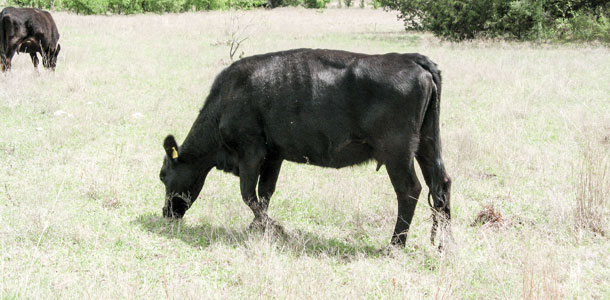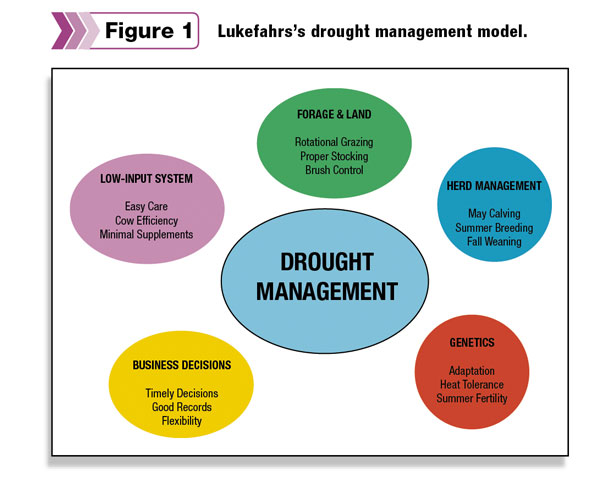Weaning dates should be governed by amount and quality of available forage. If your grazing system provides forage reserves, you have flexibility on weaning dates.

Other factors that have to be considered are body condition scores of the dams, cow reproductive cycles, market prices and cost-benefit ratios. Complete weaning is possible any time after birth with late weaning occurring between 240 days (eight months) and 280 days (slightly more than nine months).
Jack Whittier, director-chair, Panhandle Research and Extension Center, University of Nebraska – Lincoln, says, “Appropriate reasons for the traditional weaning age of 7 to 8 months in spring-calving cows include:
1. Decline in forage quantity and quality
2. Possibility of early winter storms
3. A substantial decline in the cow’s lactation curve
4. Time for the cow to prepare for her next calf
5. Tradition
There are just as many reasons to re-evaluate weaning time, particularly with regard to managing cow body condition.”
Wean early
When forage is limited, early weaning should be considered as a management tool. Time of weaning has impacts on cow and calf performance as well as health and productivity of native range or pasture.
“Lactating cows can lose body condition due to increased nutrient requirements associated with lactation,” says Dr. Greg Lardy, head of animal sciences at North Dakota State University (NDSU). “When drought conditions exist, this situation is usually made worse by lack of forage.
By weaning early, the cow’s nutrient requirements for lactation are eliminated and she is able to maintain or increase body condition prior to the fall and winter feeding period.
“During a drought, calves may not be able to successfully compete with cows for adequate forage. By weaning early and providing a highly nutritious diet, calves can reach their growth potential. Early weaning, coupled with feeding a high-concentrate diet, has resulted in increased quality grade at slaughter, according to research conducted at several universities.”
“Weaning early can result in improved conception rates, provided calves are weaned during the breeding season,” adds Dr. Carl Dahlen, extension beef cattle specialist at NDSU. “This requires weaning calves 45 to 105 days old. When weaned early enough, cows have a greater opportunity to re-breed in an optimum time frame and an increase in conception rate can be expected.
“Early weaning reduces the cow’s dry matter intake and also eliminates forage demand from the calf when it is sold. Consequently, the cows remaining on the pasture have access to more forage and demands on the pasture are reduced, which can enhance sustainability and production in the future.”
“A disadvantage is that early weaning requires greater attention to proper health, nutrition and management practices,” says Lardy. “Weaning calves earlier will result in increased backgrounding costs for the producer. Instead of pasture and their mother’s milk, early weaned calves will eat high-quality grains, hay, protein supplements or commercially prepared feeds. In addition, beef cattle producers must have facilities to feed calves or hire a custom backgrounder or feedlot to do this work.”
Wean late
Through good management of natural resources, Dr. Steven Lukefahr, Texas A&M University – Kingsville, was able to overwinter his replacement heifers on their dams and reduce input costs.

He developed a drought management model (Figure 1) using nearly 20 years of experience in aligning cattle genetics with natural climatic or seasonal cycles.
The model emphasizes the need to work with nature to avoid economic disaster. By conserving the forage base and using appropriate genetics, production costs can be dramatically reduced, and a profit can be made.
The model assumes timely implementation of various practices such as adjusting stocking rates, rotational grazing, culling less productive cows and sometimes even selling yearling breeding heifers.
One of several key components of the drought management model is use of genetically adaptable cattle. Lukefahr’s herd consists of a crossbred composite of Red Angus, Senepol and Tuli breeds.
“In 2013, a year of exceptional drought, 20 percent of the cow herd was culled early in the year, resulting in an estimated fall forage supply of 3,300 pounds per acre,” explains Lukefahr. This was after we received rain.
“On my primary permanent leases, totaling about 500 acres, most pastures were not grazed for months, resulting in enough stockpiled forage to last through the winter and spring of 2014. This forage allowed me to winter my heifers on their dams, as animals like deer and bison do in the wild.
“Wintering heifers on their dams allows calves more time to adopt or enforce desirable trait behaviors learned from their mothers, such as grazing preferences, coming when called by the manager, respecting fences and gentle disposition,”
Lukefahr continues. “During this time, heifers continue to nurse, although the dams produce less milk. However, milk during late lactation is likely to be more concentrated in fat and protein, so there should be no need to creep-feed.
As winter progresses and the nutritional value of forages declines, so will the milk supply. Again by working with nature, the calves are naturally weaned. My heifers were weaned about two months before the cows calved.”
If green forage is available, there is little harm in allowing the heifer to winter at the cow’s side. On Oct. 25, 2013, average body condition score (BCS) of Lukefahr’s cows was 5.65 with a range of 5 to 6.5. On Jan. 18, 2014, average BCS was 6.1 with a range of 5.5 to 7.
These latter body condition scores were possible because south Texas did not have a hard freeze last winter and there was green forage at the base of the mature stockpiled forage.
“The economic advantage of wintering heifers included reduced feed costs,” says Lukefahr. “Prior to 2014, it was costly and time-consuming to feed whole cottonseeds to weaned, developing heifers.
Over the last three years, the total cost of developing heifers from weaning to the date of bull turn-out (roughly 6 to 15 months old) ranged from $103 per animal to $130 excluding labor. Feed accounted for 71.8 to 81.4 percent of total costs.
“By mid-March 2014, the heifer-on-dam wintering practice cost only $3.26 per heifer for veterinary expenses. There were no feed costs. If a hard freeze had occurred, it would have been necessary to wean the heifers to prevent deterioration of the cows’ body conditions.”
Lukefahr wintered heifers that are to be used for herd replacements, but there is also an advantage to overwintering feeder calves on their dams provided there is sufficient available forage.
A study conducted at Everglades Research and Education Center at Belle Glade, Florida, showed that calves from Brahman-cross cows gained around 1.5 pounds per day between 7 and 9 months old when left with the cows for an extended nursing period.
Whether calves should be weaned early or late depends primarily upon availability of forage and body condition of the dams. That is why weaning dates should be flexible. ![]()
Robert Fears is a freelance writer based in Texas.
PHOTOS
TOP: A calf can be weaned anytime after birth.
BOTTOM: Body condition of the cow is one of the factors used to determine when calves should be weaned. Photos provided by Robert Fears.






